

PAGE 30
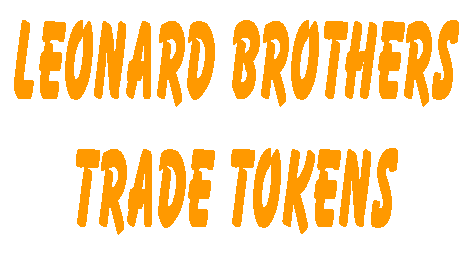
By Jerry Adams
Copyright © 1999
The tokens:
GOOD ONLY AT / ½ / CENT / LEONARD / BROS.
GOOD ONLY AT / ½ / CENT / LEONARD / BROS.
Brass-round-17mm (Fort Worth, Texas 1933-35; two types exist, the one with a vertical stroke on the letter G of Good, is the more common, estimated value 50 cents- $1, very common)

NO VALUE / 1¢ / L.B. / NOT TRANSFERABLE
NO VALUE / 1¢ / L.B. / NOT TRANSFERABLEbrass-round-19mm (Fort Worth, Texas, circa: 1933; three die varieties of 1 cent tokens exist, on type A the numeral 1 is six mm tall on both sides, on type B the numeral 1 is 3 mm tall on one side and 6 mm tall on reverse side, on type C the numeral 1 is 3mm tall on both sides) (estimated value $2 -$4)
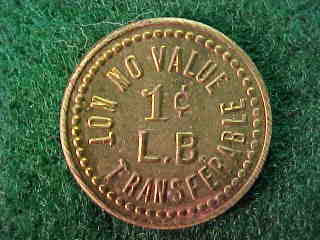
NO VALUE / 5¢ / L.B. / NOT TRANSFERABLE
NO VALUE / 5¢ / L.B. / NOT TRANSFERABLEbrass-round-21mm (circa: 1933, estimated value $5)
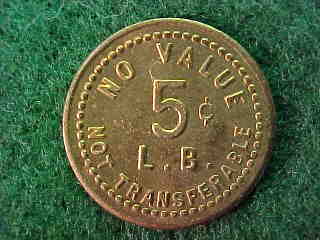
NO VALUE / 25¢ / L.B. / NOT TRANSFERABLE
NO VALUE / 25¢ / L.B. / NOT TRANSFERABLEbrass-round-24mm (circa: 1933, estimated value $8)
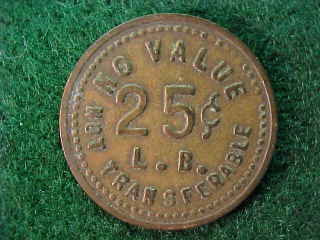
NO VALUE / 50¢ / L.B. / NOT TRANSFERABLE
NO VALUE / 50¢ / L.B. / NOT TRANSFERABLEbrass-round-30mm (circa: 1933, estimated value $9)
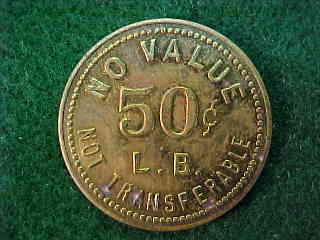
Brothers Obadiah (Obbie) and Marvin Leonard opened their first department store, with the investment of $600 in 1918, on North Houston Street in Fort Worth, Texas. Within two years, the store had grown so large, they were forced to move the operation to larger quarters on Belknap Street, which tripled its original size. The store was a huge success, and due to a knack for marketing and business, the store and the two brothers seemed to always come out ahead.
Some of the marketing ideas employed by the store, included giving a package of small gifts to newlywed couples, which included small simple items that most newlyweds needed, which were of course stamped with the Leonard Brothers name.
The stock market crash of 1929 sent the nation into an economic depression, which ultimately caused the issuance of these tokens. In 1932, Franklin D. Roosevelt defeated Herbert Hoover in the presidential elections in an electoral landslide of 472 votes to 59 votes.
The year 1933, saw changes in the world power structure, that would affect the lives of millions, as Adolf Hitler was appointed Chancellor of Germany, and Franklin D. Roosevelt was inaugurated as 32nd President of the United States. The United States was in the depths of economic depression, and on March 3, 1933, a bank moratorium was declared. All banks were closed by presidential order from March 6th through March 9th 1933. On April the 19th, 1933, the United States went off the gold standard.
Back in Fort Worth, Marvin Leonard had the idea of printing up money that could be spent at Leonard Brothers store. The idea was quickly put into play, and $100,000 of paper scrip in the denominations of $10, $5, $1 and 50 cents were printed, and special tokens were made from 50 cent down to ½ cent.
The problem was that few businesses could cash workers checks, so Leonard Brothers would cash workers checks, and give the person half of the money in cash, and half in Leonard Brothers scrip and tokens. The Leonard Brothers money found its way into general circulation in Fort Worth, and many other merchants began accepting it as they would regular currency.
Leonard Brothers had a grocery department, which also sold bread and bakery items, as well as the normal department store goods of clothing, housewares, sporting goods, hardware and such.
The reasoning for the ½ cent tokens, which are the most common of the ones listed here, was to make change for bread purchases at the bakery in Leonard Brothers, where bread was selling at two loaves for 5 cents, or 2 ½ cents each. Most folks only needed one loaf, and thus the ½ cent token.
During the late 1950’s the store constructed a private subway (named the M&O Subway) from the basement of the store, to a huge parking area adjacent to the Trinity River, just northwest of the Tarrant County Courthouse. The subway cars ran on regular steel tracks (it is still in operation today from the Tandy Complex) and emerged from the subway tunnel at the base of the Trinity River cliffs onto the Leonard Brothers parking lot. The allure was that parking on Leonard’s lot was free, and the subway ride was free. The benefit was that the customers were let off the cars in the basement "subway aisle" of Leonard Brothers store, and were apt to buy goods while passing through the store.
Leonard Bros. store 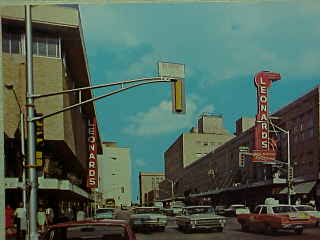 in the 1950s
in the 1950s
In the 1950’s, everyone knew the two Leonard brothers, not just by name, but by sight, as they were regularly in the store, mixing with the customers. One of the favorites of the children was Leonard’s Toyland, which was set up before Christmas in the basement, complete with the obligatory Santa Clause, and a train-like ride that traveled around the perimeter ceiling of the Toyland area. During the 50’s, Leonard’s bought out the large Everybody’s Store across the street, and expanded into their building. Some years later, Leonard Brothers store was bought by Dillards Department Store, who still maintain some of the original real estate occupied by Leonard Brothers Store. The M&O Subway still exists as a free subway, from the basement level of the two Tandy Towers in downtown Fort Worth. About all that remains of the original name of Leonard Brothers is the Leonard’s Farm and Ranch Store a few blocks east of the Tarrant County Courthouse.
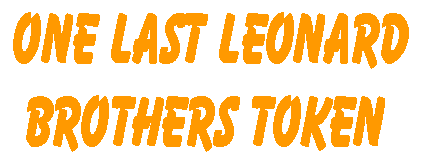
The token:
TOP / LEONARD’S / INSERT / (A2) / CAR CLEANING / CENTER
(B3) / (Q6)
white metal, slotted-round-28mm (circa: 1958-1967, one slot on obverse, two slots on reverse, car wash token, estimated value $10)
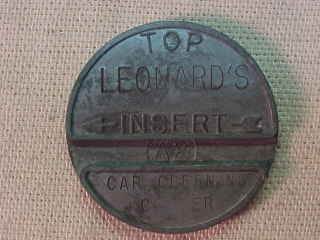
In the 1960’s, a small building stood in the middle of the Leonard Brothers parking lot near the Trinity River. This building was a car care center where there was a car wash and cleaning station which also used a token.
Go to page 31 of our token web pages...
updated: 5 feb 2000